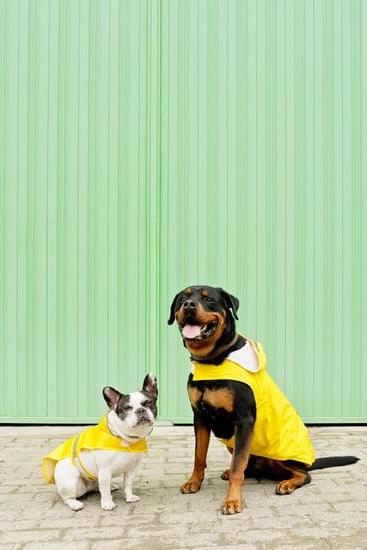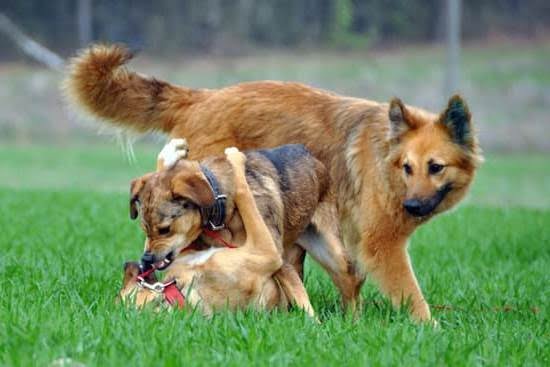Are you struggling with a hyperactive and restless dog that just can’t seem to calm down? Training your canine companion to stay calm is not only important for their overall well-being, but also for the harmony of your household. In this article, we will explore various techniques and strategies to help you train your dog to become a calmer and more well-behaved pet.
Having a calm and well-behaved dog is crucial for their happiness and quality of life. A dog that is constantly hyperactive and restless may display destructive behaviors, have difficulty focusing, and struggle with anxiety. By teaching your furry friend to stay calm, you can provide them with a sense of stability and security, while also enhancing the bond between you.
Understanding the root causes of hyperactivity in dogs is essential in addressing this behavior. We will delve into the factors that contribute to dogs being overly energetic and restless. Additionally, we will discuss the significance of mental and physical stimulation in helping to calm your dog down. Providing adequate exercise, both mentally and physically, can alleviate excess energy and promote relaxation.
Join us as we explore positive reinforcement techniques that are highly effective in training dogs. Reward-based training allows you to reinforce calm behaviors and discourage unwanted ones in a gentle manner. We will also share tips on creating a calm environment at home, as well as step-by-step instructions on relaxation exercises that can help your dog find their inner zen.
Training a hyperactive dog to remain calm requires consistency and routine. Establishing a regular training schedule will significantly improve their progress in learning how to relax. However, it’s important to remember that every dog is unique, so patience and persistence are key throughout the training journey.
In the sections that follow, we will dive deeper into these topics with practical advice and guidance. Whether you have just welcomed a new four-legged family member or are facing challenges with an older companion, this article will provide you with the knowledge and tools to train your dog to calm down. Let’s embark on this journey towards a peaceful and well-behaved pup together.
The root causes of hyperactivity in dogs
Dogs may exhibit hyperactive behavior for a variety of reasons. Understanding the root causes of this hyperactivity is crucial in effectively training your dog to calm down. Here are several factors that can contribute to dogs being overly energetic and restless:
- Breed characteristics: Certain dog breeds are naturally more energetic and have higher activity levels compared to others. For example, border collies and terriers are known for their high energy levels and need for mental stimulation. It’s important to consider the breed tendencies when training your dog to calm down, as they may require more exercise and mental stimulation.
- Lack of physical exercise: One of the primary reasons dogs become hyperactive is due to a lack of physical exercise. Dogs need regular opportunities to burn off excess energy through activities such as walks, runs, or playtime in a securely fenced area. Insufficient exercise can lead to pent-up energy, which often manifests as hyperactivity.
- Insufficient mental stimulation: Dogs also require mental exercise in addition to physical exercise. The lack of mental stimulation can result in restlessness and hyperactivity. Engaging your dog’s mind through puzzle toys, obedience training sessions, or hide-and-seek games can help tire them mentally and promote relaxation.
To address the root causes of hyperactivity in dogs, it’s essential to provide both adequate physical and mental exercises. Regular exercise helps release excess energy, making it easier for your dog to maintain a calmer demeanor. By meeting their exercise needs, you can significantly reduce hyperactivity in your furry friend.
Considering these factors when training your dog to calm down sets a solid foundation for success. Remember that every dog is unique and may require different amounts of physical and mental stimulation depending on their breed, age, and individual personality traits.
– List of root causes contributing to a hyperactive dog:
- Breed characteristics.
- Lack of physical exercise.
- Insufficient mental stimulation.
The significance of mental and physical stimulation
The importance of mental stimulation
One of the key factors in helping your dog to calm down is providing adequate mental stimulation. Dogs are intelligent creatures that require mental exercise to keep their minds engaged and prevent boredom.
When dogs become bored or lack mental stimulation, they often turn to destructive behaviors as a means of releasing pent-up energy and frustration. By incorporating activities that challenge your dog’s mind, such as puzzle toys, scent games, or obedience training, you can help redirect their energy in a positive and calming manner.
The role of physical exercise
In addition to mental stimulation, physical exercise plays a vital role in calming down hyperactive dogs. Regular exercise not only drains your dog’s excess energy but also releases endorphins that promote relaxation and reduce anxiety. Depending on your dog’s breed and size, the amount of exercise needed may vary.
However, as a general rule, aim for at least 30 minutes to an hour of moderate to intense physical activity each day for your furry friend. This can be accomplished through activities such as brisk walks, jogging, playing fetch or engaging in interactive play with other dogs.
Combining mental and physical stimulation
To achieve optimal results in calming down your dog, it is essential to combine both mental and physical stimulation. Engaging in activities that provide a balance between exercising their body and engaging their mind will not only tire them out physically but also mentally exhaust them.
Some excellent examples include agility courses where they have to navigate obstacles while following commands or taking them on an exploration walk where they encounter new sights, sounds, and scents. By incorporating both mental and physical exercises into their routine, you will find that your dog becomes more contented and relaxed overall.
Providing adequate mental and physical stimulation is crucial in helping dogs calm down. By challenging their minds and bodies through various stimulating activities, you can redirect their energy and create a sense of calmness.
Remember to always tailor the activities to your individual dog’s needs and preferences, as what works for one may not work for another. With patience, persistence, and a commitment to providing consistent mental and physical exercise, you can assist your dog in achieving a state of tranquility and well-being.
Positive reinforcement techniques
Positive reinforcement techniques are highly effective in teaching dogs to remain calm. This approach focuses on rewarding desired behaviors instead of punishing unwanted behaviors. By using positive reinforcement, you can encourage your dog to choose calm and relaxed behaviors willingly.
One of the most effective positive reinforcement techniques is clicker training. Clicker training involves using a clicker, a small handheld device that makes a distinct clicking sound when pressed. The click serves as a marker to indicate when your dog has performed the desired behavior correctly.
It is then followed by giving your dog a reward, such as treats or praise. Through consistent repetition, your dog will start associating the click with the reward and will be motivated to repeat the calming behavior.
Another positive reinforcement technique is the use of rewards, such as treats or toys, whenever your dog displays calm behaviors. For example, if your dog tends to jump and get overly excited when guests arrive, you can teach them an alternative behavior like sitting calmly. Each time they sit instead of jumping, reward them with treats or praise. Over time, this will reinforce the calm behavior and discourage the hyperactive one.
It’s important to note that timing is crucial when using positive reinforcement techniques. The reward must be given immediately after your dog exhibits the desired behavior so that they associate the reward with their action. Consistency is also key; make sure to consistently reward your dog for choosing calm behaviors in different situations.
Implementing positive reinforcement techniques not only helps teach your dog how to remain calm but also strengthens the bond between you and your furry friend through trust and communication. By focusing on rewarding rather than punishing, you create a more positive learning environment for your dog while building a lasting foundation of calmness and obedience in their behavior.
- Clicker training: Using a clicker as a marker to indicate desired behaviors
- Reward-based training: Rewarding calm behaviors with treats or praise
- Timing and consistency: Giving rewards immediately after the calm behavior and being consistent in rewarding
- Building trust and communication: Strengthening the bond between you and your dog through positive reinforcement
Creating a calm environment
Creating a calm environment plays a crucial role in helping your dog stay calm. Just like humans, dogs are affected by their surroundings, and a chaotic or stressful environment can contribute to their hyperactivity and restlessness. By creating a peaceful and relaxing atmosphere, you can greatly aid in training your dog to remain calm.
One key aspect of creating a calm environment is reducing external stimuli that may trigger your dog’s anxiety or excitement. This can include minimizing loud noises, such as loud music or television, and avoiding situations that may cause excessive excitement or fear for your dog. Additionally, establishing a designated space for your dog where they feel safe and comfortable can provide them with a sense of security.
Another tip for creating a calm environment is maintaining a consistent daily routine for your dog. Dogs thrive on routine and structure, and having consistent feeding times, exercise sessions, and sleep schedules can help regulate their energy levels. A predictable routine will also help your dog anticipate what is coming next, which can reduce anxiety and promote relaxation.
Ensuring physical comfort is also important in creating a calm atmosphere for your dog. Provide them with cozy bedding in areas where they spend time resting. Make sure the temperature is appropriate for their breed and size, as extreme heat or cold can make them restless. Additionally, consider using pheromone diffusers or calming scents to create a relaxing ambiance.
Overall, creating a calm environment involves reducing external stimuli, maintaining consistency in routine, and ensuring physical comfort for your dog. By implementing these tips and tricks, you are setting the stage for successful training sessions focused on teaching your dog to remain calm.
| Tip | Description |
|---|---|
| Minimize loud noises | Avoiding loud music or TV that may trigger anxiety |
| Designated space | Create a safe and comfortable area for your dog |
| Establish a routine | Maintain consistent feeding, exercise, and sleep schedules |
| Ensure physical comfort | Provide cozy bedding and appropriate temperatures |
| Use calming scents | Pheromone diffusers or soothing aromatherapy can help relax your dog |
Implementing relaxation exercises
To help your dog achieve a state of calmness, implementing relaxation exercises can be extremely beneficial. These exercises not only provide mental and physical stimulation but also help your dog develop better self-control. Here is a step-by-step guide on different relaxation exercises that can help your dog calm down:
- Deep Breathing: Start by getting your dog into a comfortable position, such as lying down or sitting. Gently stroke their back or chest to help them relax. As you stroke, encourage deep breathing in your dog by taking slow breaths yourself. This will help your dog synchronize their breathing with yours, promoting calmness.
- Progressive Muscle Relaxation: Begin by gently touching various parts of your dog’s body, such as their paws, tail, and ears. Gradually increase the pressure and duration of each touch as long as your dog remains relaxed. The goal is for them to learn to tolerate touch and eventually find it soothing.
- Massage: Use gentle massage techniques to relax your dog’s muscles and release any tension they may have. Start with soft strokes along their back, gradually applying more pressure based on what your dog finds comfortable. Pay attention to areas where they hold tension, such as the shoulders or hips.
- T-Touch Method: Developed by animal behaviorist Linda Tellington-Jones, the T-Touch method involves circular touches and lifts using the fingertips around specific parts of the body, such as the ears, muzzle, and ribs. These movements are believed to promote relaxation by activating neurological pathways.
Implementing these relaxation exercises regularly can have a significant impact on calming down an energetic or restless dog. Remember to be patient with your furry friend throughout the process and reinforce their efforts with praise or treats when they remain calm during the exercises.
| Relaxation Exercise | Description |
|---|---|
| Deep Breathing | Gently stroke your dog’s back or chest to help them relax and encourage deep breathing. |
| Progressive Muscle Relaxation | Gradually touch different parts of your dog’s body, increasing pressure and duration as long as they remain relaxed. |
| Massage | Use gentle massage techniques to relax your dog’s muscles and release tension. |
| T-Touch Method | Perform circular touches and lifts with fingertips on specific parts of the body to promote relaxation. |
The importance of consistency and routine
Establishing a consistent training routine and sticking to it is crucial when it comes to teaching your dog to calm down. Dogs thrive on routine and predictability, so creating a consistent schedule will help them understand what is expected of them and promote good behavior.
To start, determine a set time for feeding, walks, exercise, playtime, and rest. Feed your dog at the same times each day and take them for regular walks or exercise sessions at specific times. Building a structured routine will not only provide mental and physical stimulation for your dog but also help enforce boundaries and establish order in their daily life.
Consistency extends beyond just timing. It’s important to use the same cues, commands, and techniques throughout your training. For example, if you’re teaching your dog the “sit” command, always use the same word or hand signal whenever you want them to sit. Consistency in communication helps dogs understand what is expected of them more clearly.
In addition to consistency in timing and commands, it’s essential to be consistent with reward-based training. When your dog demonstrates calm behavior or successfully follows a command, praise them generously and give treats or rewards as positive reinforcement. This will reinforce their understanding that calm behavior is desirable and encourage them to repeat it in the future.
Remember that training takes time and patience. Your dog may not become calm overnight, but with consistent practice and reinforcement, they will make progress over time. Stay committed to the routine and be patient with both yourself and your dog as you work towards achieving a calmer state of mind together.
Seeking professional help
While many dog owners may successfully train their dogs to calm down using the techniques and tips mentioned earlier, there are some instances where seeking professional help from a dog trainer or behaviorist may be necessary. Professional assistance can provide additional guidance and expertise to address specific issues that may be causing excessive hyperactivity or restlessness in your dog.
Identifying when professional help is needed
It is important to recognize when seeking professional help is warranted. Some signs that indicate you may need assistance include:
- Severe behavioral problems: If your dog’s hyperactivity is accompanied by aggressive behavior, destructive chewing, or uncontrollable barking, it is best to consult with a professional. These behaviors can be indicators of underlying issues that require specialized training techniques.
- Lack of progress: If you have diligently followed training techniques and implemented them consistently but have not seen any improvement in your dog’s behavior over an extended period, a professional trainer can offer insights and alternative approaches tailored to your dog’s specific needs.
The benefits of professional assistance
Professional trainers or behaviorists have the experience and knowledge to analyze your dog’s behavior holistically. They can identify the root causes of your dog’s hyperactivity and develop a customized training plan that addresses those specific issues. Additionally, they are equipped with various training tools and methods that may not be readily available to most pet owners.
Another benefit of seeking professional help is receiving personalized guidance in real-time. Dog trainers and behaviorists can work directly with you and your dog, observing their behavior firsthand and providing immediate feedback for more effective training sessions. They can also teach you how to effectively communicate with your canine companion, improving both you and your dog’s understanding of each other.
Overall, seeking professional help when necessary can greatly increase the chances of successfully training your dog to calm down by addressing complex behavioral problems while providing you with the necessary tools and support for long-lasting results.
Patience and persistence
Training your dog to calm down requires a great deal of patience and persistence. It is important to understand that achieving a calm state may take time and consistency in training. Every dog is unique, and while some dogs may learn quickly, others may require more time and effort.
During the training process, it is crucial to remain patient with your furry friend. Dogs need time to understand what is expected of them and how to behave calmly. Reacting with frustration or impatience can hinder their progress and create a negative association with the training. Instead, focus on rewarding your dog for small steps towards calm behavior and acknowledge their efforts.
Persistence is key when it comes to training your dog to calm down. Consistency in your approach will help reinforce the desired behaviors over time. Establish a regular routine that includes daily exercise, mental stimulation, and relaxation exercises. Stick to this routine even if there are setbacks or challenges along the way. With consistent practice, your dog will begin to understand what is expected of them and learn how to stay calm in various situations.
Remember that each dog learns at their own pace. Some dogs may respond quickly to training techniques, while others may require more time and repetition before they start showing improvements. Stay focused on the end goal of having a well-behaved and relaxed companion, knowing that each small step forward contributes to reaching that goal.
Conclusion
In conclusion, training your dog to calm down is an important endeavor that can bring numerous benefits for both you and your furry companion. Throughout this article, we have explored various strategies to help your dog achieve a state of relaxation and reduce hyperactivity.
Firstly, understanding the root causes of hyperactivity in dogs is crucial. By recognizing the factors that contribute to their excessive energy and restlessness, such as breed predispositions or lack of mental and physical stimulation, you can better address these issues and provide tailored solutions.
One of the most effective techniques in achieving a calm demeanor in dogs is positive reinforcement. Reward-based training not only helps teach your dog to remain calm but also strengthens the bond between you and your pet. By consistently providing praise and rewards when they exhibit desired behaviors, you can encourage them to repeat these actions in the future.
Creating a calm environment is another important aspect to consider. By minimizing potential stressors and establishing a peaceful atmosphere with soothing elements, such as diffusing calming essential oils or playing soft music, you can promote relaxation in your dog’s surroundings.
Additionally, implementing relaxation exercises like deep breathing or gentle massage can further aid in calming your dog’s mind and body. These exercises serve as valuable tools in helping them unwind after times of heightened excitement or anxiety.
Consistency and routine are paramount when it comes to training your dog to be calm. Establishing a structured daily routine that incorporates regular exercise, mental stimulation, feeding schedules, and designated rest times can provide stability for your pet while reinforcing calm behavior.
While the majority of dogs respond well to training techniques implemented by their owners, there may be instances where professional help becomes necessary. If despite consistent efforts the hyperactivity persists or becomes unmanageable, seeking guidance from a qualified dog trainer or behaviorist may prove beneficial.
Lastly, it is essential to possess patience and persistence throughout the training process. Dogs learn at different paces; therefore, achieving lasting results may require time and dedication. Remember to celebrate each small success along the way and remain patient with both yourself and your dog.
By following these techniques and maintaining a positive mindset, you can help your dog calm down, leading to improved overall well-being, better behavior, and a stronger bond between you and your furry friend. With time and effort, the transformation from hyperactivity to tranquility is achievable for any canine companion.
Frequently Asked Questions
How do you calm down a hyper dog?
Calming down a hyper dog can be achieved through various methods. First and foremost, it’s important to ensure that your dog is physically and mentally stimulated. Regular exercise, such as daily walks or play sessions, can help burn off excess energy and keep your dog more relaxed overall.
Additionally, consider implementing positive reinforcement training techniques to teach your dog self-control and calm behavior. Providing a safe and quiet space for your dog to retreat to when they’re feeling overwhelmed can also be helpful in reducing their hyperactivity. Finally, establishing a consistent routine and setting clear boundaries for your dog can contribute to a calmer demeanor.
How can I calm my hyper dog naturally?
If you’re seeking natural ways to calm your hyperactive dog, there are several options to explore. Herbal remedies like chamomile or lavender can have soothing effects on dogs when used properly. You may find these in the form of essential oils or even herbal supplements designed specifically for anxiety relief in pets – always consult with a veterinarian before giving any supplements to your pet.
Aromatherapy using calming scents can also create a relaxing environment for your furry friend. It’s worth noting that not all natural remedies work the same for every dog, so it may require some trial and error to find what works best for your specific pet.
What age do most dogs calm down?
The age at which most dogs tend to calm down varies depending on breed, individual temperament, and size of the dog. Generally speaking, smaller breeds mature faster both physically and behaviorally compared to larger breeds. Small dogs may begin showing signs of calming down around one or two years old, while larger dogs might take until two or three years old or even longer.
Keep in mind that certain breeds known for their high energy levels, like Border Collies or Jack Russell Terriers, might maintain a higher level of activity throughout their lives compared to other breeds more prone to relaxation. Nevertheless, regular exercise, training sessions, and mental stimulation can still help these energetic breeds channel their energy in positive ways.

Welcome to the blog! I am a professional dog trainer and have been working with dogs for many years. In this blog, I will be discussing various topics related to dog training, including tips, tricks, and advice. I hope you find this information helpful and informative. Thanks for reading!





